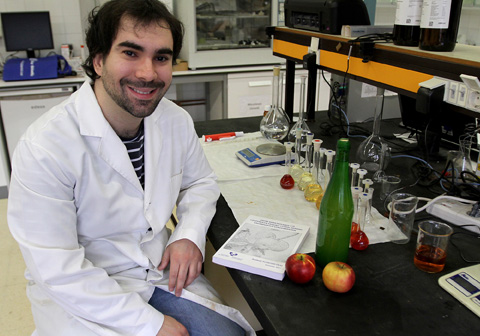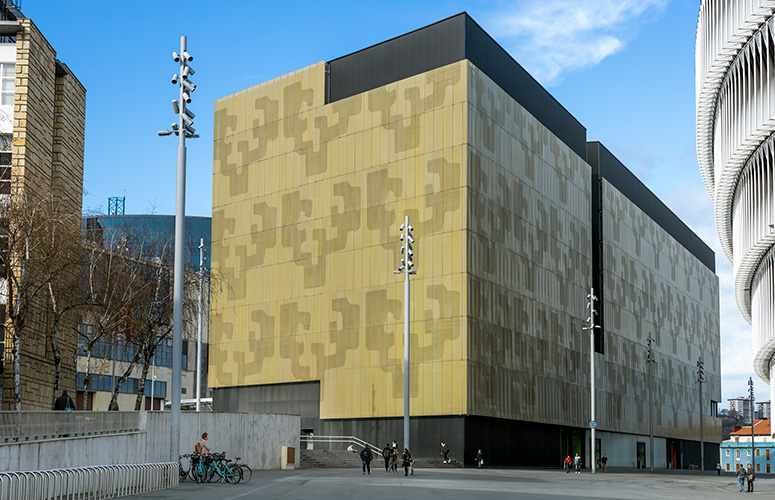Andoni Zuriarrain, a researcher at the Faculty of Chemistry of the UPV/EHU-University of the Basque Country in Donostia-San Sebastian, has analysed various single-variety ciders to find out the qualities contributed by each apple variety.
What cider gets from each type of apple
The ciders produced from the Urtebi Txiki, Manttoni and Urdin apple varieties are the most favoured ones, according to a study by the UPV/EHU
- Research
First publication date: 29/12/2017

In the Basque Country in general the cider tends to be the result of a blend of different varieties of apple, and the individual behaviour of each one of them is not known. In the research at the UPV/EHU’s Faculty of Chemistry single-variety ciders were produced using musts from a single variety of apple to find out in detail the characteristics that each type of apple contributes or could contribute towards the cider. “What we analysed were the polyphenols of the apples. The components with an antioxidant capacity are very important because firstly they are responsible for the bitter taste and astringency (dryness in the mouth), and secondly, they play a role in the darkening process of the cider because when they oxidise they produce dark compounds. They also produce cloudiness and sediments when they combine with the proteins,” explained Andoni Zuriarrain, the author of the research.
For the study 14 local varieties were selected and analysed over a three-year period. The polyphenolic profile of each apple juice was monitored, in other words, the antioxidising power of each apple, its precipitation capacity with the proteins, cloudiness, the darkening process, etc. “What happens,” said Zuriarrain, “is that the single-variety juices emphasise the characteristics of the variety of apple in question, and extreme ciders are routinely achieved”. That being the case, “in order to gain a more general perspective and find out what the best blend of varieties is for producing cider, we also did some controlled blending. Finally, we sent all the ciders produced, both the single-variety and blended ones, to the Agroambiental Fraisoro Laboratory to be tasted by a team of experts,” explained Zuriarrain. The team of experts gave each cider a score following a set of criteria, and that way they were able to find out the level of approval that these ciders could have among consumers. “It is a very important piece of data given that the aim of producing cider is that it should be drunk,” stressed the researcher.
The best apples: Urtebi Txiki, Manttoni and Urdin
The study confirmed that the ciders of the Urtebi Txiki, Manttoni and Urdin varieties were the most balanced and the ones that got the highest approval among the public. They were also the ones that got the highest score in the Fraisor lab’s tasting team. “The most peculiar cider was the one made from the Gezamina variety. Consumers are used to cider being of a specific type with some slight differences. The cider produced with Gezamina, however, was very bitter and very dark in colour, similar to beer,” explained Zuriarrain. “We also included in the group of extreme ciders the ones produced using the Moko, Merabi and Narbarte Gorria varieties owing to their high level of bitterness and acidity”, he added.
With respect to the blends, the highest points were awarded to the dual-varietal ciders. “The blends that achieved the greatest approval were Goikoetxea 40 % + Moko 60 %, Narbarte Gorria 36 % + Urtebi Txiki 64 %, Manttoni 62 % + Udare Marroi 38 %, and Frantzes Sagarra 33 % + Manttoni 67 %,” stressed Zuriarrain.
The researcher believes that all the data provided by this research could be valid for cider drinkers and for anyone who wants to produce cider: “not only to bear them in mind when the apple trees are planted but also to take these criteria into consideration when deciding what blend to make,” he concluded.
Additional information
This study was conducted as part of the PhD thesis of the researcher Andoni Zuriarrain-Ocio (Donostia/San Sebastian, 1988). The thesis is entitled “El efecto de la variedad de manzana y sus polifenoles en las características de la sidra de Euskal Herria” (The effect of the apple variety and its polyphenols on the qualities of the Basque Country’s Cider), and was supervised by Iñaki Berregi-Abalde, lecturer in the Department of Applied Chemistry of the UPV/EHU’s Faculty of Chemistry in Donostia-San Sebastian. Throughout the work they had the collaboration and support of the Association of Natural Cider of Gipuzkoa.







